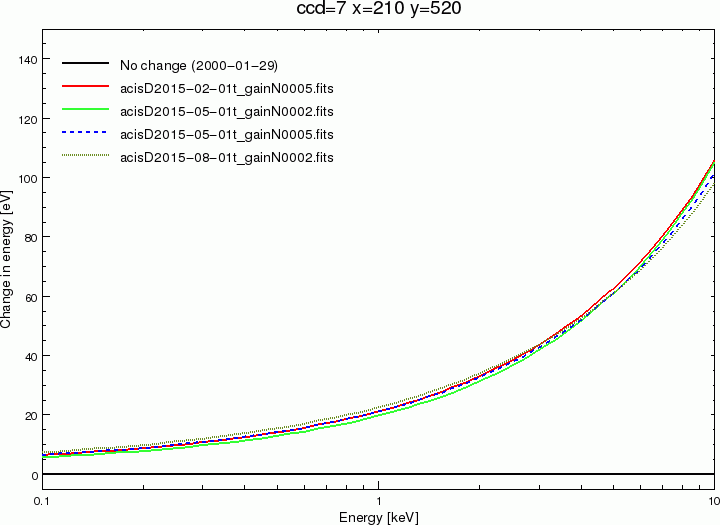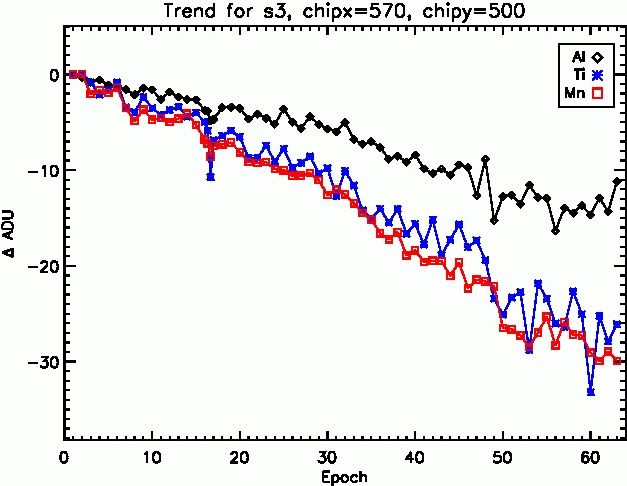CalDB 4.7.0 Public Release Notes
Public Release Date: 15 DEC 2015
SDP Installation Date: 2015-12-15T14:30:00 (UTC)
I. INTRODUCTION
CalDB 4.7.0 is an upgrade to the Chandra CalDB, which includes the following items:
- ACIS T_GAIN Epoch 63 Updates
- ACIS SUBPIX Header Mod for CC-mode
- ACIS QE for CC-mode Obs_IDs before 01 Nov 2009
- HRC-I GMAP for 2015-09-27 and Later Observations
- HRC-I PIBGSPEC for 2015-09-27 and Laer Observations
- HRC-I BKGRND Event Lists for 2014, 2015
- PIMMS Cycle 18 Effective Areas
For the CIAO 4.8 / CalDB 4.7.0 release notes see How CalDB 4.7.0 Affects Your Analysis.
II. SUMMARY OF CHANGES
A. ACIS T_GAIN Epoch 63 Updates
| Location: | $CALDB/data/chandra/acis/t_gain/ |
| Filenames: | acisD2015-05-01t_gtinN0005.fits acisD2015-05-01t_gainN0006.fits acisD2015-08-01t_gainN0002.fits acisD2015-08-01t_gain_biN0002.fits |
The periodic ACIS T_GAIN correction upgrade for Aug-Oct 2015 (Epoch 63) has been released. Modifications have also been made to the previously released Epoch 62 T_GAIN corrections (May-Aug '15). The corrections are at nominal/expected levels of less than 2% of the energy value. This upgrade as usual affects observation data taken over the two most recent T_GAIN Epochs (62 and 63), and so would update PHAs for OBS_IDs taken since 01 May 2015. Users with such datasets are encouraged to revalidate their analysis results after reprocessing their data with the upgraded CalDB files. For specific details of the new calibrations in this release, see the technical details section below.
See the ACIS T_GAIN why page for more information.
PIPELINES/TOOLS AFFECTED:
DS and CIAO level 1 (re)processing tool acis_process_events
Also: CIAO reprocessing script chandra_repro
THREADS AFFECTED:
Reprocessing Data to Create a New L2 Events File
B. ACIS SUBPIX Header Mod for CC-mode
| Location: | $CALDB/data/chandra/acis/subpix/ |
| Filename: | acisD1999-07-22subpixN0001.fits |
With the release of CIAO 4.8, modifications to acis_process_events to include an improved CTI-correction procedure for CC-mode observations are being delivered to the users for the first time. These changes had been installed in Standard Data Processing since the release of DS 10.4.2 on 30 September 2015. The improved algorithm allows that the EDSER subpixel event repositioning program to be applicable to CC-mode, and hence the CalDB SUBPIX file modifications released internally only in CalDB 4.6.10a should be included in the public CalDB 4.7.0.
See the ACIS energy-dependent pixel repositioning why page for more information.
PIPELINES/TOOLS AFFECTED:
DS and CIAO level 1 (re)processing tool acis_process_events
Also: CIAO reprocessing script chandra_repro
THREADS AFFECTED:
Reprocessing Data to Create a New L2 Events File
C. ACIS QE for CC-mode Obs_IDs before 01 Nov 2009
| Location: | $CALDB/data/chandra/acis/qe/ |
| Filename: | acisD1997-04-17qe_ccN0006.fits |
Effective on 2009-11-01T00:00:00, the CC-mode telemetry was changed to include the flight grade 66 events, which in standard processing are assigned the ASCA grade of "2". (See the CalDB 4.6.4 Release Notes.) This change allowed a more similar realization of the standard QE values in the CC-mode, so that roughly the same QE applies to CC-modes as with TE mode. However, for CC-mode observations taken before that date, the G66 events were excluded from telemetry, and hence a modification is needed to the ACIS QE for those observations.
Because most of the CC-mode data are taken with ACIS-S/grating configurations, corrections for the absence of G66 events have been derived for two ACIS-S chips, namely S2 (FI) and S3 (BI). The effect in the QE is visible only above ~3 keV, and since these chips are the only ones in the ACIS-S array that ever see those energies (except in non-calibrated higher orders), only those chips' QE curves have been changed. The ACIS QE file (now calibrated as the QE at the nearest-to-readout rows) is set up to include one extension for each chip. Therefore, one additional ACIS QE file, namely acisD1997-04-17qe_ccN0006.fits, is being introduced, and is effective only for CC-mode ObsIds taken from Launch date through 1999-11-01T00:00:00 UTC. This file has different QE data for chips S2 and S3, but the same data for the other eight chips.
See the ACIS Continuous-Clocking Mode why page for more information.
PIPELINES/TOOLS AFFECTED:
The ACIS QE_CC file above would be used by CIAO tools implemented with the "ARDLIB" analysis reference data manager. For CC-mode/GRATING observations, the script fullgarf is probably the most relevant.
THREADS AFFECTED:
D. HRC-I GMAP for 2015-09-27 and Later Observations
| Location: | $CALDB/data/chandra/hrc/gmap/ |
| Filename: | hrciD2015-09-27sampgainN0001.fits |
A new HRC-I GMAP has been generated for the (UTC) periods 2015-09-27T12:00:00 to the present and extending into 2016. The corrections are generated using G21.5-0.9, and HZ 43 observations regularly taken for calibration purposes on HRC-I, and a concentrated sequence of Ar Lac observations taken near and around the aim point, which for this year occurred in Sep 2015. The HRC-I gain continues to decline at a rate of about 5% per year, and the annual gain map updates are necessary to maintain a 2% consistency in the PI across the MCP. See the technical details section below for a more detailed description of this year's updates.
See also the HRC-I Gain Maps why page for more information on the HRC-I Gain Map.
PIPELINES/TOOLS AFFECTED:
HRC SDP and CIAO Level 1 (re)processing tool hrc_process_events Also: CIAO reprocessing script chandra_repro
THREADS AFFECTED:
Reprocessing Data to Create a New L2 Events File
E. HRC-I PIBGSPEC for 2015-09-27 and Laer Observations
| Location: | $CALDB/data/chandra/hrc/pibgspec |
| Filename: | hrciD2015-09-27pibgspecN0001.fits |
A corresponding upgrade to the PIBGSPEC library for 2015 has also been derived from the new GMAP data, adding a new file for the same effective time period as the above HRC-I GMAP. The background PI spectra are created from HRC-I calibration observations of AR Lac taken yearly at the 21 locations on the detector shown in Fig. 5 above. For each year, level 2 event lists are created by reprocessing the data with the latest CIAO/CALDB version. Time-dependent gain corrections are applied to the scaled SUMAMPS values to create PI. The new file is to be added to CalDB simultaneously with the 2015 GMAP update. More details on this and previous PI Background spectra files for the HRC-I are given in the technical details section below.
PIPELINES/TOOLS AFFECTED:
None. The PIBGSPEC files are selected for a given Obs_ID using the hrc_bkgrnd_lookup script with the parameter caltype=spectrum.
THREADS AFFECTED:
The HRC-I Background Spectra Files
F. HRC-I BKGRND Event Lists for 2014, 2015
| Location: | $CALDB/data/chandra/hrc/bkgrnd/ |
| Filename: | hrciD2014-01-01bkgrndN0002.fits hrciD2015-01-01bkgrndN0002.fits |
As per the original HRC Stowed Position Background Study, the CalDB is to be annually updated with HRC-I background event lists effective for one full calendar year. As indicated in the contributed page How to Create a Background Map for an Observation, two new HRC-I stowed-position background data sets have been compiled and released to users applicable to calendar years 2014 and 2015, respectively. These have been adapted to CalDB and the applicable CIAO thread for generating fluxed images using the BKGRND files. The "time" columns were removed, the EXPOSURE keywords with appropriate values have been added to the headers, along with the CalDB indexing keywords. These are to be added to the existing 14 annually displaced HRC-I BKGRND files already present in CalDB, which extended from 2000 to 2013 previously.
See the HRC-I Background Vignetting why page for more information on use of the HRC-I BKGRND event lists to remove vignetting rings from exposure maps.
PIPELINES/TOOLS AFFECTED:
CIAO tool reproject_events is used to tailor an appropriate HRC-I BKGRND event list to a give observation. The CIAO script fluximage selects the appropriate BKGRND file from CalDB, and uses it to generate background-subtracted fluxed images.
THREADS AFFECTED:
The HRC-I Background Event Files
HRC-I Exposure Map and Exposure-corrected Image
G. PIMMS Cycle 18 Effective Areas
| Location: | $CALDB/data/chandra/pimms/acis/ |
| Filename: | acisiD2015-11-17pimmsN0018.fits acisihetg0D2015-11-17pimmsN0018.fits acisiletg0D2015-11-17pimmsN0018.fits acissD2015-11-17pimmsN0018.fits acissheg1D2015-11-17pimmsN0018.fits acisshegmeg1D2015-11-17pimmsN0018.fits acisshetg0D2015-11-17pimmsN0018.fits acissleg1D2015-11-17pimmsN0018.fits acissletg0D2015-11-17pimmsN0018.fits acissmeg1D2015-11-17pimmsN0018.fits |
| Location: | $CALDB/data/chandra/pimms/hrc/ |
| Filename: | hrciD2015-11-17pimmsN0018.fits hrciletg0D2015-11-17pimmsN0018.fits hrcsD2015-12-02pimmsN0018.fits hrcsleg1D2015-12-02pimmsN0018.fits hrcsleghiD2015-12-02pimmsN0018.fits hrcsletg0D2015-12-02pimmsN0018.fits |
The PIMMS effective areas were generated for use in the Cycle 18 internal proposal planning tools release. These effective areas are not ARFs or GARFs to be used in analysis of specific data; they are maintained in the CalDB as a repository for the current and previous proposal cycles, for the PIMMS effective area viewer and count rate calculator. The proposal planning build at the CXC is the only system that properly reads these EAs and builds them into the PIMMS tools.
See the Pitfalls using PIMMS for Observed Data for an explanation of why users should not access these files for analysis purposes.
See the PIMMS effective area viewer at the Location:
PIMMS Effective Area Viewer
and the PIMMS count rate calculator at:
PIMMS Count-rate Calculator
III. TECHNICAL DETAILS
A. ACIS T_GAIN Epoch 63 Updates
The ACIS time-dependent gain corrections (T_GAIN) have recently been updated for current changes from the previous T_GAIN epoch, specifically Epoch 63, which was Aug-Oct 2015. With the addition of these new corrections, derived from ACIS External Cal Source (ECS) data taken during radiation zone passes, the CalDB files extending from May through July 2015 (i.e. Epoch 62) have been finalized, and new non-interpolating T_GAIN files are now implemented for Epoch 63.
The magnitudes (in eV) of the new gain corrections, versus photon energy, are given in Figs. 1-3 below. The corrections are of the usual order in magnitude, specifically less than 2.0% of the photon energy value. Fig. 1 below gives the corrections for the ACIS-I aimpoint on chip ACIS-3, for the CTI-corrected case, which is the only one applicable to FI chips. Figure 2 gives the corrections for the ACIS-S aimpoint on ACIS-7, for the case where the BI chips are CTI-corrected. Finally Fig. 3 gives the corrections for ACIS-7 for NON-CTI-corrected BI chips. These would be relevant to GRADED DATAMODE observations with ACIS-S, for example.

Fig. 1: ACIS-I3 aimpoint T_GAIN corrections in eV versus photon energy.

Fig. 2: ACIS-S3 CTI-corrected aimpoint T_GAIN corrections in eV versus photon energy.

Fig. 3: ACIS-S3 non-CTI-corrected aimpoint T_GAIN corrections in eV versus photon energy.
Long term trends for chips I3 and S3 are plotted below in Figure 4a and b, through Epoch 63, the latest release. The chip locations for these plots are given in the respective labels above the plots. Note that the locations are not the aimpoint positions, as with Figs. 1-3 above, but are near the centers of each chip. The full CTI correction has been applied to the data in both figures.
B. ACIS SUBPIX Header Mod for CC-mode
The specific header change for each of the ten extensions (one for each ACIS chip) is given below.
Previously the second boundary condition in each header was set to:
CBD20001 = DATAMODE(FAINT,FAINT_BIAS,GRADED,VFAINT)
The new setting, with DS10.4.2, is as follows:
CBD20001 = DATAMODE(FAINT,FAINT_BIAS,GRADED,VFAINT,CC33_GRADED,CC33_FAINT)
C. ACIS QE for CC-mode Obs_IDs before 01 Nov 2009
The new ACIS-S3 and S2 QE curves were derived by analyzing corresponding TE and CC-mode observations of objects with appropriate grating spectra. Because the actual effect is to exclude all Flight Grade 66 events, it was assumed that the effect was global, and affected the readout QE globally, and was not applicable to an adjustment to the QE Uniformity calibration.
The new ACIS CC-mode QE file is applicable to only about 100 archival Chandra observations. None employ the ACIS-I array, even in part. Hence there was no need to attempt to recalibration any of ACIS chips 0-3.
The effect of compensation for untelemetered Flight Grade=66 events appears only at photon energies above ~3 keV. As shown in Fig 5 below, the energy cut-off for 3 keV photons occurs within the ACIS-S2 and S3 portions of the ACIS array for all three of the grating types (LEG, MEG, and HEG) aboard Chandra. This justifies the corrections for this effect being applied only to the QE curves of those two chips.
D. HRC-I GMAP for 2015-09-27 and Later Observations
E. HRC-I PIBGSPEC for 2015-09-27 and Laer Observations
F. HRC-I BKGRND Event Lists for 2014, 2015



